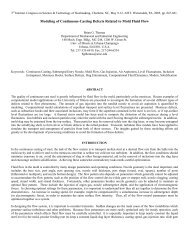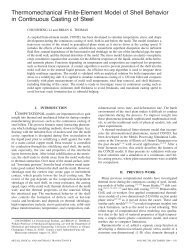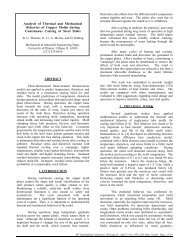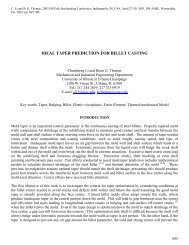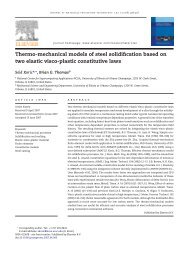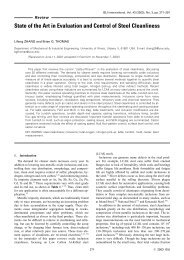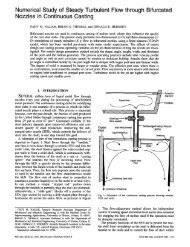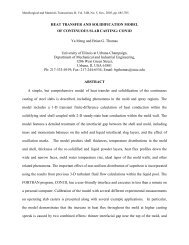Kun Xu - Continuous Casting Consortium - University of Illinois at ...
Kun Xu - Continuous Casting Consortium - University of Illinois at ...
Kun Xu - Continuous Casting Consortium - University of Illinois at ...
You also want an ePaper? Increase the reach of your titles
YUMPU automatically turns print PDFs into web optimized ePapers that Google loves.
ANNUAL REPORT 2009<br />
UIUC, August 5, 2009<br />
Modeling he<strong>at</strong> transfer, precipit<strong>at</strong>e<br />
form<strong>at</strong>ion, and grain growth during<br />
secondary spray cooling<br />
<strong>Kun</strong> <strong>Xu</strong><br />
(Ph.D. Student)<br />
Department <strong>of</strong> Mechanical Science and Engineering<br />
<strong>University</strong> <strong>of</strong> <strong>Illinois</strong> <strong>at</strong> Urbana-Champaign<br />
<strong>University</strong> <strong>of</strong> <strong>Illinois</strong> <strong>at</strong> Urbana-Champaign • Metals Processing Simul<strong>at</strong>ion Lab • <strong>Kun</strong> <strong>Xu</strong> • 1<br />
Objectives<br />
Cracks form during cooling due to:<br />
- tensile stress<br />
- low ductility<br />
To design temper<strong>at</strong>ure histories to<br />
avoid crack form<strong>at</strong>ion, need accur<strong>at</strong>e<br />
predictive tools<br />
Models can now accur<strong>at</strong>ely predict<br />
temper<strong>at</strong>ure and stress histories<br />
Need tools to predict metallurgical<br />
behavior to estim<strong>at</strong>e hot ductility, such<br />
as grain size, precipit<strong>at</strong>e form<strong>at</strong>ion<br />
<strong>University</strong> <strong>of</strong> <strong>Illinois</strong> <strong>at</strong> Urbana-Champaign • Metals Processing Simul<strong>at</strong>ion Lab • <strong>Kun</strong> <strong>Xu</strong> • 2
Specific applic<strong>at</strong>ion:<br />
transverse surface cracks<br />
casting direction<br />
transverse cracks<br />
Widespread crazing and fine<br />
transverse cracks <strong>at</strong> oscill<strong>at</strong>ion<br />
marks on the as-cast surface <strong>of</strong><br />
a line pipe steel slab (top side)<br />
E. S. Szekeres,Proceedings <strong>of</strong> the 6th Intern<strong>at</strong>ional Conference on Clean Steel, Hungary, 2002.<br />
<strong>University</strong> <strong>of</strong> <strong>Illinois</strong> <strong>at</strong> Urbana-Champaign • Metals Processing Simul<strong>at</strong>ion Lab • <strong>Kun</strong> <strong>Xu</strong> • 3<br />
mold<br />
gap<br />
Effect <strong>of</strong> depressions on grain size and cracks<br />
Steel shell<br />
Molten steel pool<br />
Larger grains and cracks bene<strong>at</strong>h depressions &<br />
oscill<strong>at</strong>ion marks<br />
Due to:<br />
More he<strong>at</strong> flow resistance across gap<br />
Higher shell temper<strong>at</strong>ure<br />
Faster grain growth<br />
Causes:<br />
Tensile strain concentr<strong>at</strong>ion area<br />
Make hot grains actually align (Secondary<br />
recrystalliz<strong>at</strong>ion) to form “blown grains”<br />
Embrittled with the large numbers <strong>of</strong> fine<br />
precipit<strong>at</strong>es <strong>at</strong> weak grain boundaries —<br />
transverse cracks open up along boundaries<br />
<strong>University</strong> <strong>of</strong> <strong>Illinois</strong> <strong>at</strong> Urbana-Champaign • Metals Processing Simul<strong>at</strong>ion Lab • <strong>Kun</strong> <strong>Xu</strong> • 4
Mechanism <strong>of</strong> surface crack form<strong>at</strong>ion<br />
with precipit<strong>at</strong>e embrittlement<br />
STAGE I - Normal solidific<strong>at</strong>ion on mold<br />
wall. Surface grains are small but highly<br />
oriented.<br />
γ<br />
STAGE III - Nitride precipit<strong>at</strong>es<br />
begin to form along the blown<br />
grain boundaries. Microcracks<br />
initi<strong>at</strong>e <strong>at</strong> weak boundaries.<br />
γ<br />
STAGE IV - Ferrite transform<strong>at</strong>ion<br />
begins and new precipit<strong>at</strong>es form<br />
<strong>at</strong> boundaries. Existing microcracks<br />
grow & new ones form.<br />
STAGE II - Surface grains “blow” locally due to high<br />
temper<strong>at</strong>ure (>1350 o C) and strain, especially <strong>at</strong> the<br />
base <strong>of</strong> deeper oscill<strong>at</strong>ion marks.<br />
γ γ<br />
γ γ<br />
E. S. Szekeres,Proceedings <strong>of</strong> the 6th Intern<strong>at</strong>ional Conference on Clean Steel, Hungary, 2002.<br />
STAGE V - At the straightener,<br />
microcracks propag<strong>at</strong>e and<br />
become larger cracks, primarily<br />
on top surface <strong>of</strong> the strand.<br />
<strong>University</strong> <strong>of</strong> <strong>Illinois</strong> <strong>at</strong> Urbana-Champaign • Metals Processing Simul<strong>at</strong>ion Lab • <strong>Kun</strong> <strong>Xu</strong> • 5<br />
Cracks open up <strong>at</strong> weak grain boundaries<br />
<strong>Casting</strong> direction<br />
~1mm<br />
E. S. Szekeres,Proceedings <strong>of</strong> the 6th Intern<strong>at</strong>ional Conference on Clean Steel, Hungary, 2002.<br />
Crazing around a transverse<br />
crack <strong>at</strong> base <strong>of</strong> an oscill<strong>at</strong>ion<br />
mark on the as-cast top surface<br />
<strong>of</strong> a 0.2%C steel slab<br />
Note larger grain size (typical<br />
size ~1mm) <strong>at</strong> the base <strong>of</strong><br />
oscill<strong>at</strong>ion mark<br />
<strong>University</strong> <strong>of</strong> <strong>Illinois</strong> <strong>at</strong> Urbana-Champaign • Metals Processing Simul<strong>at</strong>ion Lab • <strong>Kun</strong> <strong>Xu</strong> • 6
Hot ductility varies with temper<strong>at</strong>ure and<br />
grade due to precipit<strong>at</strong>e form<strong>at</strong>ion<br />
B.G. Thomas et al, ISS Transactions, 1986, 7-20.<br />
<strong>University</strong> <strong>of</strong> <strong>Illinois</strong> <strong>at</strong> Urbana-Champaign • Metals Processing Simul<strong>at</strong>ion Lab • <strong>Kun</strong> <strong>Xu</strong> • 7<br />
Micrographs <strong>of</strong> precipit<strong>at</strong>es in steels<br />
Complex precipit<strong>at</strong>es with TiN core<br />
TiNb(C) precipit<strong>at</strong>es <strong>at</strong> grain boundaries<br />
V. Ludlow et al, Precipit<strong>at</strong>ion <strong>of</strong> nitrides and carbides during solidific<strong>at</strong>ion and cooling, unpublished work.<br />
M. Charleux et al, Metallurgical and M<strong>at</strong>erials Transactions A, 2001, vol.32A, 1635-1647.<br />
<strong>University</strong> <strong>of</strong> <strong>Illinois</strong> <strong>at</strong> Urbana-Champaign • Metals Processing Simul<strong>at</strong>ion Lab • <strong>Kun</strong> <strong>Xu</strong> • 8
Project Overview<br />
He<strong>at</strong> Transfer<br />
Program: CON1D<br />
Ductility Prediction<br />
Phase fraction &<br />
temper<strong>at</strong>ure history<br />
Grain size<br />
Equilibrium<br />
Precipit<strong>at</strong>ion Model<br />
Equilibrium<br />
concentr<strong>at</strong>ion<br />
Kinetic Model<br />
(precipit<strong>at</strong>es)<br />
Grain Growth<br />
Model<br />
Volume fraction &<br />
size distribution<br />
Final goal Predict ductility and combine with other models to<br />
design casting practices to prevent cracks<br />
<strong>University</strong> <strong>of</strong> <strong>Illinois</strong> <strong>at</strong> Urbana-Champaign • Metals Processing Simul<strong>at</strong>ion Lab • <strong>Kun</strong> <strong>Xu</strong> • 9<br />
Equilibrium precipit<strong>at</strong>ion model<br />
Reaction xM + yX <br />
M M: metal, X: C, N, S or O<br />
x X y<br />
x y<br />
Solubility product: KM[ ] [ ] /<br />
x X = a<br />
y M ⋅a<br />
X a<br />
α (MxXy) : activity <strong>of</strong> precipit<strong>at</strong>es<br />
( MxXy) [%i]: dissolved concentr<strong>at</strong>ion <strong>of</strong><br />
i j<br />
ai = fi[% i]<br />
where log fi = ei[% i] +∑ei<br />
[% j]<br />
element i<br />
Mutual Solubility: If two precipit<strong>at</strong>es have the same crystal structures and similar<br />
l<strong>at</strong>tice parameters (
Groups <strong>of</strong> precipit<strong>at</strong>es<br />
The current model has 18 precipit<strong>at</strong>es, 13 alloying elements and 4 groups <strong>of</strong> mutually<br />
soluble precipit<strong>at</strong>es<br />
• TiN, TiC, NbN, NbC 0.87 , VN, V 4 C 3 (f.c.c structure) l<strong>at</strong>tice mism<strong>at</strong>ch ~7.92%<br />
– Valid<strong>at</strong>ed by many experimental observ<strong>at</strong>ions<br />
• Al 2 O 3 , Ti 2 O 3 (hexagonal structure) l<strong>at</strong>tice mism<strong>at</strong>ch ~8.06%<br />
• MgO, MnO (f.c.c structure) l<strong>at</strong>tice mism<strong>at</strong>ch ~5.54%<br />
• MnS, MgS (f.c.c structure) l<strong>at</strong>tice mism<strong>at</strong>ch ~0.38%<br />
• SiO 2 (trigonal structure)<br />
• TiS (trigonal structure)<br />
• Ti 4 C 2 S 2 (hexagonal structure)<br />
• AlN (hexagonal structure)<br />
• BN (hexagonal structure)<br />
• Cr 2 N (hexagonal structure)<br />
• A complete system <strong>of</strong> 35 nonlinear equ<strong>at</strong>ions is solved with Newton-Raphson method<br />
<strong>University</strong> <strong>of</strong> <strong>Illinois</strong> <strong>at</strong> Urbana-Champaign • Metals Processing Simul<strong>at</strong>ion Lab • <strong>Kun</strong> <strong>Xu</strong> • 11<br />
Valid<strong>at</strong>ion for mutually exclusive precipit<strong>at</strong>es<br />
NbN after adding Al<br />
NbN after adding B<br />
AlN<br />
NbN<br />
BN<br />
NbN NbN before before adding adding Al B<br />
Three hypothetical steels<br />
1. 0.02%Nb and N<br />
2. 0.02%Nb and N, 0.02% Al<br />
3. 0.02%Nb and N, 0.01% B<br />
Second order equ<strong>at</strong>ion and<br />
analytical solution exists<br />
Existing precipit<strong>at</strong>e AlN or<br />
BN delays the precipit<strong>at</strong>e<br />
NbN to form <strong>at</strong> the lower<br />
temper<strong>at</strong>ure and decreases the<br />
equilibrium amount <strong>of</strong> NbN <strong>at</strong><br />
the same temper<strong>at</strong>ure<br />
<strong>University</strong> <strong>of</strong> <strong>Illinois</strong> <strong>at</strong> Urbana-Champaign • Metals Processing Simul<strong>at</strong>ion Lab • <strong>Kun</strong> <strong>Xu</strong> • 12
Pseudo-ternary diagram for Al-Nb-N system<br />
Fix the sum <strong>of</strong> weight percent concentr<strong>at</strong>ion (Al+Nb+N) as 0.05%<br />
0.75<br />
0.50<br />
0.25<br />
Nb<br />
0.00<br />
1.00<br />
none<br />
0.75<br />
0.50<br />
0.25<br />
Nb<br />
0.00<br />
1.00<br />
1.00<br />
1.00<br />
AlN<br />
0.00<br />
0.00<br />
Al 0.00 0.25 0.50 0.75 1.00 N<br />
Al 0.00 0.25 0.50 0.75 1.00 N<br />
0.75<br />
0.50<br />
0.25<br />
Nb<br />
0.00<br />
1.00<br />
0.75<br />
none 0.50<br />
NbN<br />
AlN<br />
0.25<br />
1.00<br />
0.00<br />
Al 0.00 0.25 0.50 0.75 1.00 N<br />
<strong>University</strong> <strong>of</strong> <strong>Illinois</strong> <strong>at</strong> Urbana-Champaign • Metals Processing Simul<strong>at</strong>ion Lab • <strong>Kun</strong> <strong>Xu</strong> • 13<br />
Ti 0.26 Nb 0.24 N 0.50<br />
T=1350 o C<br />
T=1150 o C<br />
0.75<br />
0.75<br />
0.50<br />
0.50<br />
0.25<br />
none<br />
0.75<br />
T=1300 o C<br />
0.25<br />
Nb<br />
0.00<br />
1.00<br />
none<br />
AlN<br />
0.75<br />
NbN<br />
NbN+AlN<br />
T=1125 o C<br />
0.50<br />
0.50<br />
0.25<br />
0.25<br />
1.00<br />
0.00<br />
Al 0.00 0.25 0.50 0.75 1.00 N<br />
Test problem for mutually solubility<br />
(Ti-Nb-N system)<br />
Ti 0.38 Nb 0.12 N 0.50<br />
Ti 0.48 Nb 0.02 N 0.50<br />
<strong>University</strong> <strong>of</strong> <strong>Illinois</strong> <strong>at</strong> Urbana-Champaign • Metals Processing Simul<strong>at</strong>ion Lab • <strong>Kun</strong> <strong>Xu</strong> • 14<br />
none<br />
Three hypothetical steels<br />
1. 0.01%Nb and N<br />
2. 0.01%Nb and N, 0.005% Ti<br />
At least fourth order equ<strong>at</strong>ion<br />
and no analytical solution<br />
Mutual solubility decreases<br />
the activity <strong>of</strong> NbN, which<br />
allows more NbN to form<br />
Without consider<strong>at</strong>ion <strong>of</strong><br />
mutual solubility, NbN<br />
precipit<strong>at</strong>es would decrease<br />
with Ti additions
Molar fraction <strong>of</strong> precipit<strong>at</strong>es<br />
1E-3<br />
1E-4<br />
1E-5<br />
Valid<strong>at</strong>ion with stability <strong>of</strong> TiS and Ti 4 C 2 S 2<br />
Ti 2 O 3<br />
Ti 4 C 2 S 2<br />
TiC<br />
TiN<br />
Al 2 O 3<br />
TiS<br />
1E-6<br />
1000 1050 1100 1150 1200 1250 1300 1350<br />
Temper<strong>at</strong>ure (centigrade)<br />
1E-6<br />
1000 1050 1100 1150 1200 1250 1300 1350<br />
<strong>University</strong> <strong>of</strong> <strong>Illinois</strong> <strong>at</strong> Urbana-Champaign • Metals Processing Simul<strong>at</strong>ion Lab • <strong>Kun</strong> <strong>Xu</strong> • 15<br />
Steel<br />
Nb1<br />
Nb8<br />
Steel<br />
B<br />
C 0.0033 0.0040 0.081 0.0115 0.037 0.050 0.0022 0.0036<br />
Recorded types <strong>of</strong> observed precipit<strong>at</strong>es in experiments (m<strong>at</strong>ches prediction)<br />
Measurements: X. Yang et al, ISIJ Intern<strong>at</strong>ional, 1996, vol.36, 1286-1294.<br />
Steel<br />
B<br />
C<br />
C<br />
0.085<br />
0.081<br />
C<br />
0.0036<br />
1300 o C<br />
TiN<br />
TiN, TiS<br />
Si<br />
0.0050<br />
Mn<br />
0.081<br />
1250 o C<br />
TiN, TiS *<br />
TiN, TiS<br />
S<br />
0.0028<br />
1200 o C<br />
TiN, TiS<br />
TiN, TiS<br />
Molar fraction <strong>of</strong> precipit<strong>at</strong>es<br />
1E-3<br />
1E-4<br />
1E-5<br />
Al<br />
0.045<br />
1150 o C<br />
TiN, TiS<br />
Ti 4 C 2 S 2<br />
0.095<br />
TiC<br />
Ti<br />
TiN, Ti 4C 2S 2<br />
TiN<br />
Al 2 O 3<br />
TiS<br />
Temper<strong>at</strong>ure (centigrade)<br />
Steel B Steel C<br />
N<br />
0.0019<br />
1100 o C<br />
TiN, Ti 4C 2S 2<br />
TiN, TiS * , Ti 4C 2S 2<br />
<strong>University</strong> <strong>of</strong> <strong>Illinois</strong> <strong>at</strong> Urbana-Champaign • Metals Processing Simul<strong>at</strong>ion Lab • <strong>Kun</strong> <strong>Xu</strong> • 16<br />
O<br />
0.0028<br />
Valid<strong>at</strong>ion with equilibrium Nb(C,N) precipit<strong>at</strong>ion<br />
experiments (microalloy steel)<br />
Si<br />
0.28<br />
0.31<br />
Mn<br />
1.46<br />
1.44<br />
P<br />
0.008<br />
0.01<br />
0.002<br />
0.002<br />
Measurements: S. Zajac and B. Jansson, Metallurgical and M<strong>at</strong>erials Transactions B, 1998, vol.29B, 163-176.<br />
Solution tre<strong>at</strong>ed (1300 o C) 1 hour<br />
Followed by w<strong>at</strong>er quenching<br />
Then aged <strong>at</strong> different isothermal<br />
temper<strong>at</strong>ure for 24-48 hours<br />
Cool to ambient quickly<br />
Measure Nb amount in Nb(C,N) by<br />
the inductively coupled plasma<br />
(ICP) emission method<br />
Nb precipit<strong>at</strong>ed as Nb(C,N) (wt%)<br />
0.04<br />
0.03<br />
0.02<br />
0.01<br />
S<br />
Nb<br />
0.013<br />
0.033<br />
Al<br />
0.013<br />
0.017<br />
N<br />
0.005<br />
0.004<br />
V<br />
0.014<br />
0.011<br />
Prediction <strong>of</strong> Nb1<br />
Measurement <strong>of</strong> Nb1<br />
Prediction <strong>of</strong> Nb8<br />
Measurement <strong>of</strong> Nb8<br />
Ti<br />
0.003<br />
0.003<br />
0.00<br />
850 900 950 1000 1050 1100 1150 1200 1250<br />
Temper<strong>at</strong>ure (centigrade)
Temper<strong>at</strong>ure and steel phase fraction model<br />
CON1D Program: Solve the transient he<strong>at</strong> conduction in the mold and spray regions <strong>of</strong><br />
continuous steel slab casters using finite difference method<br />
The program is calibr<strong>at</strong>ed to predict the temper<strong>at</strong>ure <strong>of</strong> the real casters.<br />
Example: thin slab casting <strong>of</strong> low-carbon 1006N2 steel<br />
Steel<br />
1006N2<br />
Phase fraction<br />
1.0<br />
0.8<br />
0.6<br />
0.4<br />
0.2<br />
C<br />
0.0472<br />
N<br />
0.0083<br />
S<br />
0.0013<br />
Liquid<br />
Delta ferrite<br />
Austenite<br />
Alpha ferrite<br />
Mn<br />
0.9737<br />
0.0<br />
650 800 950 1100 1250 1400 1550<br />
Temper<strong>at</strong>ure ( o C)<br />
Si<br />
0.2006<br />
0.0084<br />
0.0123<br />
0.0027<br />
0.0223<br />
0.0001<br />
0.0354<br />
<strong>University</strong> <strong>of</strong> <strong>Illinois</strong> <strong>at</strong> Urbana-Champaign • Metals Processing Simul<strong>at</strong>ion Lab • <strong>Kun</strong> <strong>Xu</strong> • 17<br />
Ti<br />
Nb<br />
V<br />
Slab size: 90mm thick, 1396mm wide<br />
Mold length: 950mm<br />
Pouring Temper<strong>at</strong>ure: 1553 o C<br />
<strong>Casting</strong> speeds: 2.8m/min and 4.6m/min<br />
Al<br />
Liquidus temper<strong>at</strong>ure: 1524.4 o C<br />
Solidus temper<strong>at</strong>ure: 1500.7 o C<br />
Equilibrium Precipit<strong>at</strong>ion in continuous casting <strong>of</strong><br />
1006N2 Steel<br />
Mold length 0.95m, start <strong>of</strong> first spray zone 0.85m, end <strong>of</strong> last spray zone 11.25m<br />
Only precipit<strong>at</strong>es predicted to form are: (Ti,Nb,V)(C,N), MnS and AlN<br />
7.5m: Ti 0.326 Nb 0.173 V 0.006 N 0.424 C 0.071<br />
0.85m: Ti 0.333 Nb 0.166 V 0.006 N 0.429 C 0.066<br />
V=2.8m/min<br />
7.5m: Ti 0.361 Nb 0.138 V 0.005 N 0.446 C 0.050<br />
15m: Ti 0.338 Nb 0.161 V 0.006 N 0.433 C 0.062 0.85m: Ti0.419 Nb 0.081 V 0.002 N 0.463 C 0.035<br />
V=4.6m/min<br />
<strong>University</strong> <strong>of</strong> <strong>Illinois</strong> <strong>at</strong> Urbana-Champaign • Metals Processing Simul<strong>at</strong>ion Lab • <strong>Kun</strong> <strong>Xu</strong> • 18<br />
B<br />
15m: Ti 0.428 Nb 0.072 V 0.002 N 0.466 C 0.032<br />
Higher casting speed causes higher temper<strong>at</strong>ure and less precipit<strong>at</strong>es (same spray flows)<br />
TiN is most stable <strong>at</strong> high temper<strong>at</strong>ure because <strong>of</strong> its low solubility limit. For the higher<br />
casting speed, AlN does not form in the mold.<br />
Cr
Particle Collision<br />
Particle Diffusion<br />
Kinetic model for precipit<strong>at</strong>e growth<br />
dni<br />
1<br />
= (1 + ) Φ nn − n (1 + ) Φ n ( i≥2)<br />
dt 2<br />
dn<br />
dt<br />
i<br />
i−1<br />
∑ δki , −kki , −kki−k nM<br />
i∑ δik<br />
, ik , k<br />
k= 1 k=<br />
1<br />
Gener<strong>at</strong>ion <strong>of</strong> size i particle by<br />
collision <strong>of</strong> smaller particles k and i-k,<br />
only count once for reacting particles<br />
Loss <strong>of</strong> size i particle by<br />
collision with any particle j,<br />
double loss if both particle i<br />
=− βinn 1 i + βi−1nn 1 i− 1 − αiAn i i + αi+<br />
1Ai+ 1ni+ 1 ( i≥2)<br />
Particle<br />
Diffusion<br />
(i→i+1)<br />
Particle<br />
Diffusion<br />
(i-1→i)<br />
Particle<br />
Dissolution<br />
(i→i-1)<br />
Particle<br />
Dissolution<br />
(i+1→i)<br />
Collision happens only in liquid, and diffusion happens in both liquid and solid<br />
ni : Number density <strong>of</strong> size i particle (m-3 )<br />
Фij : Collision coefficient for collision between size i and size j particle (m3 /s)<br />
βi : Diffusion r<strong>at</strong>e constant <strong>of</strong> size i particle (m3 /s)<br />
αi : Dissolution r<strong>at</strong>e per unit area <strong>of</strong> size i particle (m-2s-1 i 4 1 i<br />
)<br />
Dr β π =<br />
α = βn exp( 2 σV<br />
/ RTr) / A<br />
i i 1, eq m i i<br />
<strong>University</strong> <strong>of</strong> <strong>Illinois</strong> <strong>at</strong> Urbana-Champaign • Metals Processing Simul<strong>at</strong>ion Lab • <strong>Kun</strong> <strong>Xu</strong> • 19<br />
Introduction <strong>of</strong> Particle Size Grouping (PSG) model<br />
The model always simul<strong>at</strong>es from nuclei (~ 0.1nm) up to large coarsened particles<br />
(~100μm): particles could contain 1~10 18 molecules<br />
Serious comput<strong>at</strong>ion and memory storage issues arise with such a large size range<br />
Solve with PSG method: Use N G groups (
Size group and particle radius for constant R V<br />
<strong>University</strong> <strong>of</strong> <strong>Illinois</strong> <strong>at</strong> Urbana-Champaign • Metals Processing Simul<strong>at</strong>ion Lab • <strong>Kun</strong> <strong>Xu</strong> • 21<br />
Valid<strong>at</strong>ion <strong>of</strong> test problem for collision<br />
1/ 2 3<br />
Turbulent collision Φ = 1.3( ε / ν)<br />
( r + r ) with only single molecules initially<br />
Dimensionless form<br />
n 0 : Initial number density <strong>of</strong> single molecules; ε, ν, r 1 are input parameters<br />
Initial condition (t*=0 ): n 1 * =1 and ni *=0 for i≥2 (same for N i in PSG model))<br />
Boundary condition: n M *=0, or N G *=0 <strong>at</strong> all t *<br />
Exact solution: n M =12000; PSG model: N G =16 (R V =2) or N G =11 (R V =3)<br />
Dimensionless numder density<br />
1<br />
0.1<br />
0.01<br />
1E-3<br />
1E-4<br />
1E-5<br />
N 1<br />
N 2<br />
N 3<br />
ij i j<br />
n = n / n<br />
*<br />
i i<br />
1E-6<br />
1E-3 0.01 0.1 1<br />
N 4<br />
N 5<br />
Dimensionless time<br />
0<br />
t = 1.3( ε / ν)<br />
r n t<br />
R V =2.0<br />
N6 N7 N8 N9 N10 * 1/2 3<br />
1 0<br />
N11 N12 Dimensionless numder density<br />
1E-6<br />
1E-3 0.01 0.1 1<br />
Dimensionless time<br />
<strong>University</strong> <strong>of</strong> <strong>Illinois</strong> <strong>at</strong> Urbana-Champaign • Metals Processing Simul<strong>at</strong>ion Lab • <strong>Kun</strong> <strong>Xu</strong> • 22<br />
1<br />
0.1<br />
0.01<br />
1E-3<br />
1E-4<br />
1E-5<br />
N 1 RV =3.0<br />
N 2<br />
N 3<br />
N 4<br />
N 5<br />
N 6<br />
N7 N8 N 9
L<br />
n j<br />
Develop new PSG method for diffusion<br />
dN V V<br />
ceil( V ) floor( V )<br />
dt V V V V<br />
U<br />
n j<br />
j<br />
= 1 U<br />
βjN1( Nj −nj ) − 1<br />
L<br />
αjAj( Nj − nj) +<br />
j− 1, j U U<br />
βj−1Nn 1 j− 1+ j, j+<br />
1 L L L<br />
αj+<br />
1Aj+ 1nj+ 1<br />
j j j j<br />
Diffusion<br />
inside group j<br />
Dissolution<br />
inside group j<br />
Diffusion<br />
group j-1→j<br />
floor( V ) ceil( V )<br />
− Nn − An ( j≥2)<br />
V V<br />
j, j+ 1 U<br />
βj 1<br />
U<br />
j<br />
j−1, j L<br />
αj<br />
L<br />
j<br />
L<br />
j<br />
j j<br />
Diffusion<br />
group j→j+1<br />
Dissolution<br />
group j→j-1<br />
Dissolution<br />
group j+1→j<br />
: Number density <strong>of</strong> particles in group j, which jumps into group j-1 by dissolution after<br />
losing only one single molecule<br />
: Number density <strong>of</strong> particles in group j, which jumps into group j+1 by diffusion after<br />
getting only one single molecule<br />
Estim<strong>at</strong>ed from geometric progression <strong>of</strong> the number densities for two neighboring size groups<br />
<strong>University</strong> <strong>of</strong> <strong>Illinois</strong> <strong>at</strong> Urbana-Champaign • Metals Processing Simul<strong>at</strong>ion Lab • <strong>Kun</strong> <strong>Xu</strong> • 23<br />
Dimensionless number density<br />
10<br />
1<br />
0.1<br />
0.01<br />
1E-3<br />
1E-4<br />
1E-5<br />
1E-6<br />
Valid<strong>at</strong>ion <strong>of</strong> test problem for diffusion<br />
Dimensionless form<br />
*<br />
ni = ni / n1,<br />
eq<br />
*<br />
t = 4π Drn 11 1, eqt<br />
Molecules produced by an isothermal first order reaction<br />
nM<br />
* * * * *<br />
n ( t ) = n ( t )/ n = i⋅ n = 9[1−exp( −0.1<br />
t )]<br />
s s 1, eq i<br />
i=<br />
1<br />
Initial condition (t*=0 ): n i *=0 for i≥1 (same for N i in PSG model)<br />
Boundary condition: n M *=0, or N G *=0 <strong>at</strong> all t*<br />
Exact solution: n M =16000; PSG model: N G =17 (R V =2) or N G =12 (R V =3)<br />
R V =2.0<br />
N 1<br />
N 2<br />
N 3<br />
N4 N5 N6 N7 N8 N9 ∑<br />
N 10<br />
N 11<br />
N 12<br />
N 13<br />
1 10 100 1000<br />
N 14<br />
0<br />
0.01 0.1 1 10 100<br />
Dimensionless time<br />
Dimensionless time<br />
<strong>University</strong> <strong>of</strong> <strong>Illinois</strong> <strong>at</strong> Urbana-Champaign • Metals Processing Simul<strong>at</strong>ion Lab • <strong>Kun</strong> <strong>Xu</strong> • 24<br />
Dimensionless number density<br />
10<br />
1<br />
0.1<br />
0.01<br />
1E-3<br />
1E-4<br />
1E-5<br />
1E-6<br />
R V =3.0<br />
N 1<br />
N 2<br />
N 3<br />
N4 N5 N6 N7<br />
1 10 100 1000<br />
*<br />
N s<br />
10<br />
8<br />
6<br />
4<br />
2<br />
N 8<br />
Dimensionless time<br />
N 9
Storage<br />
Comput<strong>at</strong>ional<br />
time<br />
Compare comput<strong>at</strong>ional cost for test problems<br />
Exact<br />
n M =12000<br />
~225 hours<br />
Collision<br />
PSG (R v =2)<br />
N G =16<br />
~0.8s<br />
PSG (R v =3)<br />
N G =11<br />
~7420s<br />
<strong>University</strong> <strong>of</strong> <strong>Illinois</strong> <strong>at</strong> Urbana-Champaign • Metals Processing Simul<strong>at</strong>ion Lab • <strong>Kun</strong> <strong>Xu</strong> • 25<br />
~0.4s<br />
Exact<br />
n M =16000<br />
Diffusion<br />
PSG (R v =2)<br />
N G =17<br />
~358s<br />
PSG (R v =3)<br />
For constant RV , the number <strong>of</strong> size groups in PSG method must s<strong>at</strong>isfy<br />
V<br />
NG<br />
−1<br />
= R > n → N = Ceil(log n ) + 1+ 1 (last one for boundary group)<br />
NGV M<br />
G RVM N G =12<br />
~248s<br />
* Calcul<strong>at</strong>ion is run with M<strong>at</strong>lab on Dell OPTIPLEX GX270 with P4 3.20GHz CPU and 2GB RAM<br />
The comput<strong>at</strong>ional time is proportional to n M 2 or NG 2 for collision problem (double<br />
loop), and n M or N G for diffusion problem (single loop)<br />
Comput<strong>at</strong>ion cost is dram<strong>at</strong>ically reduced, especially for the problem with a large<br />
variety <strong>of</strong> precipit<strong>at</strong>e sizes because <strong>of</strong> logarithm rel<strong>at</strong>ion<br />
Sample results for AlN particles<br />
V M =1.33×10 -5 m 3 /mol, σ=0.2~0.75J/m 2<br />
DAl =3*10-3exp(-234500/RT) m2 /s, DN =9.1*10-5exp(-168500/RT) m2 /s<br />
6770<br />
Solubility product in austenite log K<br />
1.03 , Al0 =0.011wt%, N0 =0.009wt%<br />
AlN =− +<br />
T<br />
Choose RV =2 and 30 size groups, ∆t=1×10-3s, Implicit Euler with Gauss-Seidel<br />
iter<strong>at</strong>ive method<br />
Amount <strong>of</strong> dissolved elements and precipit<strong>at</strong>e (wt%)<br />
0.0175<br />
0.0150<br />
0.0125<br />
0.0100<br />
0.0075<br />
0.0050<br />
0.0025<br />
0.0000<br />
700 750 800 850 900 950 1000 1050 1100<br />
Temper<strong>at</strong>ure ( o C)<br />
Dissolved aluminum<br />
Dissolved nitrogen<br />
AlN precipit<strong>at</strong>e<br />
1E-15<br />
700 750 800 850 900 950 1000<br />
Temper<strong>at</strong>ure ( o C)<br />
<strong>University</strong> <strong>of</strong> <strong>Illinois</strong> <strong>at</strong> Urbana-Champaign • Metals Processing Simul<strong>at</strong>ion Lab • <strong>Kun</strong> <strong>Xu</strong> • 26<br />
D(m 2 /s)<br />
1E-11<br />
1E-12<br />
1E-13<br />
1E-14<br />
N<br />
Al
Choose σ=0.5J/m 2<br />
Calcul<strong>at</strong>ed size distribution<br />
Growth (10~100s) is quick,<br />
coarsening (100-500s) is slow<br />
Lower temper<strong>at</strong>ure causes higher<br />
nucle<strong>at</strong>ion r<strong>at</strong>e, thus large number <strong>of</strong><br />
fine precipit<strong>at</strong>ed particles are observed<br />
<strong>University</strong> <strong>of</strong> <strong>Illinois</strong> <strong>at</strong> Urbana-Champaign • Metals Processing Simul<strong>at</strong>ion Lab • <strong>Kun</strong> <strong>Xu</strong> • 27<br />
Π= N1/ N1,<br />
eq<br />
Temper<strong>at</strong>ure<br />
900 o C<br />
850 o C<br />
800 o C<br />
750 o C<br />
Gener<strong>at</strong>e PTT diagram<br />
Nt / N1,<br />
eq −Π<br />
f =<br />
N / N −1<br />
5% precipit<strong>at</strong>ed<br />
178.1s<br />
60.2s<br />
40.3s<br />
38.5s<br />
t 1, eq<br />
Precipit<strong>at</strong>ed (500s)<br />
94.4%<br />
97.0%<br />
97.3%<br />
97.6%<br />
Experimental PTT curves <strong>of</strong><br />
AlN precipit<strong>at</strong>ed in austenite <strong>of</strong><br />
0.051%Al-0.0073%N steel<br />
Nose temper<strong>at</strong>ure (~800 o C)<br />
J. P. Michel et al, Acta Metallurgica,<br />
1981, 513-526.<br />
Quicker precipit<strong>at</strong>ion and higher<br />
nose temper<strong>at</strong>ure: interfacial energy<br />
value are between 0.5-0.75J/m 2<br />
<strong>University</strong> <strong>of</strong> <strong>Illinois</strong> <strong>at</strong> Urbana-Champaign • Metals Processing Simul<strong>at</strong>ion Lab • <strong>Kun</strong> <strong>Xu</strong> • 28
Grain growth model<br />
Grain growth in austenite under the presence <strong>of</strong> precipit<strong>at</strong>es<br />
(1/ n−1)<br />
dD * ⎛ Qapp<br />
⎞⎡1 1 f ⎤<br />
= M 0 exp⎜−<br />
⎟⎢<br />
−<br />
dt RT ⎣Dkr⎥ ⎝ ⎠ ⎦<br />
M0 *: Kinetic constant th<strong>at</strong> represents grain boundary mobility (m2 /s)<br />
Qapp : Apparent activ<strong>at</strong>ion energy for grain growth (J/mol)<br />
n: Exponent to measure resistance to grain boundary motion<br />
f and r: the volume fraction and radius <strong>of</strong> precipit<strong>at</strong>es<br />
K: Zener coefficient rel<strong>at</strong>ed to pinning efficiency <strong>of</strong> the precipit<strong>at</strong>es.<br />
The maximum grain diameter in the presence <strong>of</strong> precipit<strong>at</strong>es is defines as D = kr/ f<br />
Calcul<strong>at</strong>ion begins from the temper<strong>at</strong>ure <strong>of</strong> totally austenite structure, the initial austenite<br />
grain size is assumed to be with the order <strong>of</strong> the primary dendrite arm spacing (PDAS)<br />
( )<br />
m n<br />
1 K CR( C0)<br />
λ = K=278.75, m=–0.20628, n=–0.3162+2.0325C 0 for 0≤C 0 ≤0.15 (wt pct)<br />
I. Andersen and Ø Grong, Acta Metallurgica M<strong>at</strong>erialia, 1995.<br />
M. E. Bealy and B. G. Thomas, Metallurgical and M<strong>at</strong>erials Transactions B, 1996.<br />
<strong>University</strong> <strong>of</strong> <strong>Illinois</strong> <strong>at</strong> Urbana-Champaign • Metals Processing Simul<strong>at</strong>ion Lab • <strong>Kun</strong> <strong>Xu</strong> • 29<br />
Grain growth <strong>of</strong> 1006N2 steel in continuous casting<br />
Neglect the influence <strong>of</strong> precipit<strong>at</strong>es<br />
dD * ⎛ Qapp<br />
⎞⎡1 1 f ⎤<br />
= M 0 exp⎜−<br />
⎟⎢<br />
−<br />
dt RT ⎣Dkr⎥ ⎝ ⎠ ⎦<br />
Fully austenite temper<strong>at</strong>ure 1384 o C<br />
Cooling r<strong>at</strong>e estim<strong>at</strong>ed by CON1D<br />
Without precipit<strong>at</strong>es: the grains large<br />
enough to cause cracks<br />
Rough estim<strong>at</strong>ion: At surface, volume<br />
fraction <strong>of</strong> TiN 1.45*10 -4 <strong>at</strong> mold exit<br />
by choosing ρ steel =7500kg/m 3 and<br />
ρ TiN =5420kg/m 3 , typical average TiN<br />
particle size 10~100nm and k=4/3. the<br />
maximum grain size is calcul<strong>at</strong>ed<br />
within the range <strong>of</strong> 90~900µm<br />
(1/ n−1)<br />
Grain size (mm)<br />
1.6<br />
1.2<br />
0.8<br />
0.4<br />
Lim<br />
M 0 * =4×10 -3 m 2 /s, n=0.5,<br />
Q app =167686+40562(wt%C p )<br />
wt%C p =wt%C-0.14wt%Si+0.04wt%Mn<br />
J. Reiter, C. Bernhard and H. Presslinger, MS&T 2006,<br />
Cincinn<strong>at</strong>i, USA.<br />
surface (V=2.8) surface (V=4.6)<br />
0.5mm (V=2.8) 0.5mm (V=4.6)<br />
0.0<br />
10mm (V=2.8) 10mm (V=4.6)<br />
0 3 6 9 12 15<br />
Distance from meniscus (m)<br />
<strong>University</strong> <strong>of</strong> <strong>Illinois</strong> <strong>at</strong> Urbana-Champaign • Metals Processing Simul<strong>at</strong>ion Lab • <strong>Kun</strong> <strong>Xu</strong> • 30<br />
mold<br />
exit
Conclusions (equilibrium precipit<strong>at</strong>ion<br />
model)<br />
1) An equilibrium precipit<strong>at</strong>ion model is established, which includes<br />
consider<strong>at</strong>ion <strong>of</strong> solubility limit with Wagner interaction effect, mutual<br />
solubility and complete mass conserv<strong>at</strong>ion <strong>of</strong> alloying elements.<br />
2) The influence <strong>of</strong> mutual solubility on precipit<strong>at</strong>ion behaviors is carefully<br />
considered. Pseudo-ternary precipit<strong>at</strong>ion diagram is produced.<br />
3) The model is valid<strong>at</strong>ed with analytical solutions <strong>of</strong> simple cases and<br />
experimental measurements <strong>of</strong> liter<strong>at</strong>ures. Good agreements are found.<br />
4) The model is applied for practical 100N2 steel and continuous casting<br />
with two casting speed. TiNbV(CN), Mns and AlN are only possible<br />
precipit<strong>at</strong>es th<strong>at</strong> could form. TiN is the mainly precipit<strong>at</strong>es <strong>at</strong> high<br />
temper<strong>at</strong>ure especially in the mold because <strong>of</strong> its lowest solubility limit.<br />
With higher speed, AlN does not form in the mold.<br />
<strong>University</strong> <strong>of</strong> <strong>Illinois</strong> <strong>at</strong> Urbana-Champaign • Metals Processing Simul<strong>at</strong>ion Lab • <strong>Kun</strong> <strong>Xu</strong> • 31<br />
Conclusions (kinetic model)<br />
1) Comparing with some empirical or semi-empirical kinetic precipit<strong>at</strong>ion models,<br />
the suggested precipit<strong>at</strong>e growth mechanisms by collision and diffusion are<br />
fundamentally based and all parameters are physically significant.<br />
2) The PSG method is suggested and valid<strong>at</strong>ed for particle agglomer<strong>at</strong>ion due to<br />
collision and diffusion. Within a wide range <strong>of</strong> volume r<strong>at</strong>ios, R V , mass balance<br />
is s<strong>at</strong>isfied and good m<strong>at</strong>ches are found. Because the accuracy <strong>of</strong> the PSG<br />
method increases with decreasing R V , an R V <strong>of</strong> 2.0 seems optimal.<br />
3) PSG method needs only a small number <strong>of</strong> size groups to simul<strong>at</strong>e particle<br />
agglomer<strong>at</strong>ion, and huge saving <strong>of</strong> memory storage and comput<strong>at</strong>ional time is<br />
found by comparison with solving initial problem without losing mass balance<br />
and sacrificing the desired accuracy.<br />
4) In addition to gener<strong>at</strong>e volume fraction and size distribution <strong>of</strong> precipit<strong>at</strong>ed<br />
particles, the PSG method is used to gener<strong>at</strong>e the PTT diagram.<br />
<strong>University</strong> <strong>of</strong> <strong>Illinois</strong> <strong>at</strong> Urbana-Champaign • Metals Processing Simul<strong>at</strong>ion Lab • <strong>Kun</strong> <strong>Xu</strong> • 32
Conclusions (grain growth)<br />
1) In continuous casting, the grain growth model predicts grains approaching 50%<br />
<strong>of</strong> their final size by mold exit. The grains under 0.5mm oscill<strong>at</strong>ion marks are <strong>at</strong><br />
least 10% larger than those on the slab surface due to local high temper<strong>at</strong>ure.<br />
Without precipit<strong>at</strong>es, the grains are large enough to cause ductility problems<br />
2) It is expected th<strong>at</strong> the larger grains and lack <strong>of</strong> fine precipit<strong>at</strong>es are likely the<br />
controlling factors to cause coarse grains and susceptibility to surface cracks<br />
bene<strong>at</strong>h the oscill<strong>at</strong>ion marks. A program for coupling all the above models is<br />
necessary and important in future work<br />
<strong>University</strong> <strong>of</strong> <strong>Illinois</strong> <strong>at</strong> Urbana-Champaign • Metals Processing Simul<strong>at</strong>ion Lab • <strong>Kun</strong> <strong>Xu</strong> • 33<br />
Acknowledgements<br />
• <strong>Continuous</strong> <strong>Casting</strong> <strong>Consortium</strong> Members<br />
(ABB, Arcelor-Mittal, Baosteel, Corus, Delavan/Goodrich,<br />
LWB Refractories, Nucor, Nippon Steel, Postech, Steel<br />
Dynamics, ANSYS-Fluent)<br />
• Pr<strong>of</strong>. B. G. Thomas<br />
• Other gradu<strong>at</strong>e students in CCC groups<br />
<strong>University</strong> <strong>of</strong> <strong>Illinois</strong> <strong>at</strong> Urbana-Champaign • Metals Processing Simul<strong>at</strong>ion Lab • <strong>Kun</strong> <strong>Xu</strong> • 34



